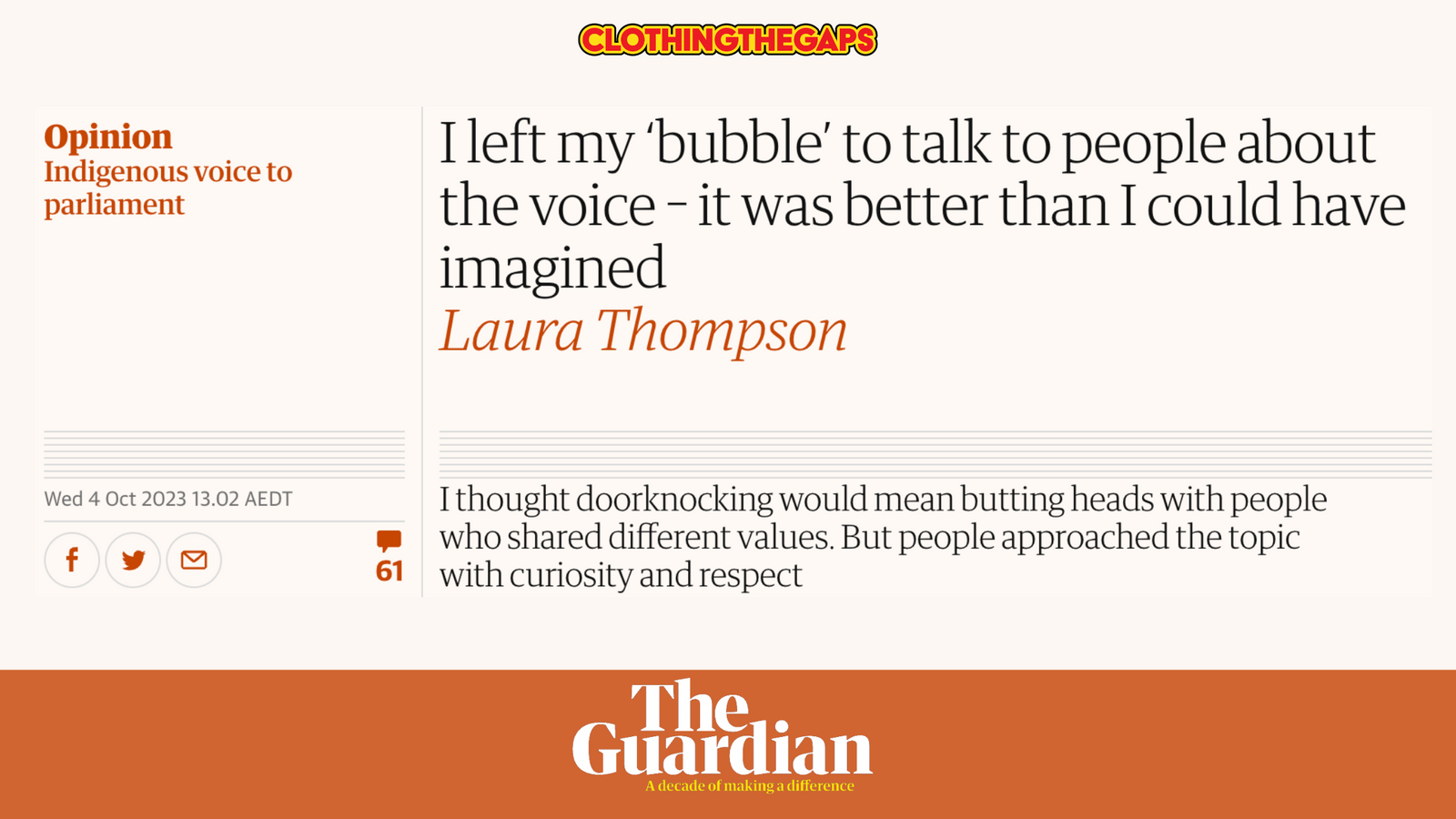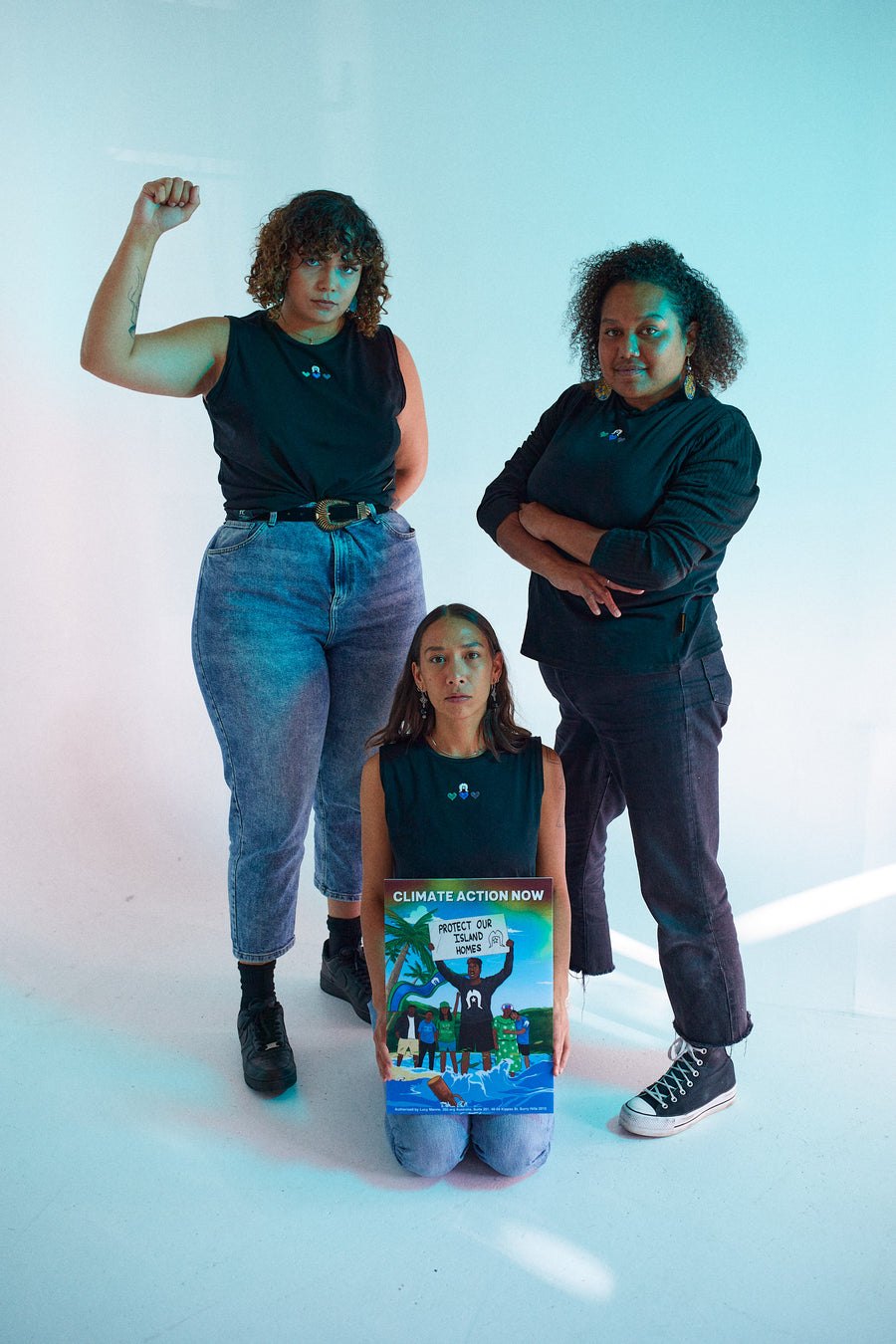Referendum ·
Voice ·
What happened when I went door knocking for 'Yes'

I left my ‘bubble’ to talk to people about the voice – it was better than I could have imagined
I thought doorknocking would mean butting heads with people who shared different values. But people approached the topic with curiosity and respect.
I’m a Gunditjmara woman and the cofounder of Clothing The Gaps, a Victorian Aboriginal social enterprise. I spearheaded the #FreeTheFlag campaign after we received a cease and desist for using Aboriginal flag on our clothes. After two and half years of community support, we finally freed the flag and put it back it the public domain where it belongs.
With this background in advocacy, you might be surprised to hear that I’ve never been doorknocking before. But last weekend I decided to get out of my comfort zone and give it a go and I urge you to do the same.
I’m not a big fan of confrontation. I’ve always favoured respectful dialogue and a well thought out social media post or blog and I assumed doorknocking would mean butting heads with people who aggressively shared different values. I decided to give it a go anyway. A referendum on an Indigenous voice to parliament was too important to lose.
On Sunday, I drove out to Faulkner, an area in Melbourne that the ‘Yes’ Campaign said needed attention. In the safety of my inner-north Melbourne “Brunswick bubble” I’m usually quite comfortable in my red black and yellow Aboriginal slogan tees and my trusty fluro crocs. Today, I felt the need to impress, I didn’t want to put anyone off with my political fashion fits so, I levelled up with a smart lime green blazer, my white ‘History is calling’ tee and woven Aboriginal earrings.
My anxiety about what to wear was fuelled by what I didn’t know would greet me when I knocked on an unknown door. I also knew, in these conversations, my identity would be judged more than ever.
Faulkner is a suburb I haven’t spent much time in. My trips there have mainly consisted of visits to the cemetery. A morbid reality for many in the Victorian Aboriginal community.
The local shops were unexpectedly delightful, there was a cute florist and the local café had a mural painted with flags from all over the world. This included the Aboriginal flag – the same flag I fought tirelessly and successfully to “free”. Faulkner suddenly felt safer.
You couldn’t miss the group of ‘Yes’ volunteers at the park in all their yes paraphernalia and we gathered in a circle before we began doorknocking. We heard from elected representative of the First Peoples Assembly of Victoria – the ‘Voice’ for Treaty in Victoria – about why they were there and their personal reasons for backing ‘Yes’.
We then partnered off, one person who had experience doorknocking and one of us newbies. The Yes campaign provided us maps, materials and scripts so we knew how to answer any curly questions that came our way.@clothing_the_gaps Come door knocking with us! #VoiceTreatyTruth#Yes#DoorKnocking volunteer @Yes23 ♬ original sound - Clothing The Gaps We had our scripts. We had our buddies beside us. I took a moment to complete my outfit with a ‘yes’ badge. Our armour was on and we were ready to go.What I encountered was better than I could have imagined. It was definitely not as scary as I thought, and people approached our conversation with curiosity and respect.We spoke to a man who didn’t know the Referendum was even happening. This man had a vast understanding of Indigenous rights, particularly international Indigenous rights focusing on climate change.He said he would be voting ‘yes’ and sent us on our way with cups of delicious lentil soup. This interaction nearly moved me to tears. We uncovered a human gem – who will no doubt go on to influence his friends and family to vote ‘yes’ too.We doorknocked a share house, they answered the door bleary eyed and hungover from the night before. They assured us they were voting ‘yes’ and we left them to rehydrate and eat something greasy.We came across a strong ‘No’ voter. His opposition came from his distrust of politicians and the idea that there were already First Nations politicians in Canberra.We explained those politicians were there to represent their political parties, their constituents and not their Aboriginal community. He ended up taking a ‘yes’ pamphlet from us and I thanked him for having the conversation. I knew we gave him a different perspective to consider. It was a fascinating interaction because I would usually never talk to someone who shared polar opposite views to myself – one thing is certain this man softened in his short interaction with us and dare I say it, I think he liked us! My buddy explained to me no matter what you must leave every house with a positive impression. So, if someone does slam the door in your face you reply, “thanks have a lovely day!”.
A lovely Nepalese man we spoke to said he would vote ‘yes’ to support our country because he knew we would support his. We gave him a pamphlet and told him where to get further information in Nepali. He then had to take his children to taekwondo training, where he would see his good friend who was also voting ‘yes’.
A jetlagged lady, who had just returned from overseas, answered the door and said she was likely to vote ‘no’ because she heard the voice would have veto power. We explained this wasn’t the case and I believe we swung her around to ‘yes’.
These interactions show the power of conversation – whether it was alerting people to the referendum happening, directing someone to where they can get information in a language other than English, clarifying mistruths or just simply giving another perspective – it was a couple of hours well spent.
What’s abundantly clear is that, for this referendum to succeed, we need to face our fears and have those tough and uncomfortable conversations.Every conversation and impression right now really does count.Laura Thompson is the cofounder of Clothing the Gaps, a Victorian Aboriginal social enterprise.Useful resources:









Leave a comment